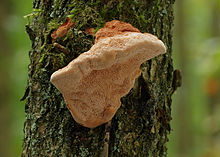Hapalopilus rutilans
The species grows on the fallen or standing dead wood of deciduous trees, in which it fruits singly, in groups, fused, or in overlapping clusters.
The fruit bodies are neurotoxic if ingested, an effect attributable to the compound polyporic acid, which is present in high concentrations.
The species was first described in 1791 by French mycologist Jean Baptiste François Pierre Bulliard, who called it Boletus suberosus.
[5] The fungus has been shuffled to several genera throughout its taxonomic history,[1] including Boletus (Kurt Sprengel, 1827),[6] Inonotus (Petter Karsten, 1881), Phaeolus (Narcisse Théophile Patouillard, 1900),[7] Polystictus (François-Xavier Gillot and Jean Louis Lucand, 1890),[8] and Agaricus (Ernst Hans Ludwig Krause, 1933).
The cap surface is covered with matted hairs, has shallow concentric furrows, and a dull brownish-orange color.
[22] A chemical test can be used to help identify H. rutilans: all parts of the fruit body will instantly stain bright violet if a drop of an alkaline solution is applied.
Phellinus gilvus has a yellowish to rusty-yellow fibrous cap, yellowish-brown flesh that stains black in KOH, and a grayish-brown to dark brown pore surface.
Its pore surface is bright reddish orange when fresh, and its flesh stains red with KOH.
[19] Also edible, the "chicken of the woods", Laetiporus sulphureus, has bright yellow fruit bodies whose color fades in age.
Fruit bodies of the fungus grow singly, in groups, or in fused and overlapping clusters on the wood of dead and decaying deciduous trees.
[20] Preferred hosts include Quercus (oak), Fagus (beech), and Betula (birch), although on rare occasions it has been recorded on conifer wood as well.
[22] Reported for the first time from India in 2011, it was found in forests depots of Chhattisgarh, growing on the stored logs of several native trees: Anogeissus latifolia, Chloroxylon swietenia, Desmodium oojeinense, Shorea robusta, and Terminalia elliptica.
[27] Fungus beetle species known to inhabit and rear their young in the fruit bodies of Hapalopilus rutilans include Sulcacis affinis, Hallomenus axillaris, H. binotatus, and Orchesia fasciata.
[32] Similar symptoms and recovery were reported in a 2013 poisoning case, in which the fungus was confused with the edible Fistulina hepatica.
